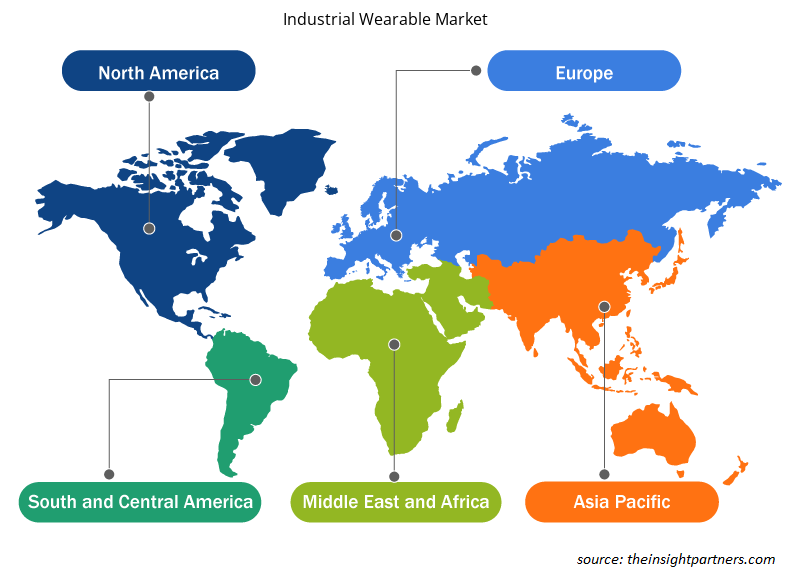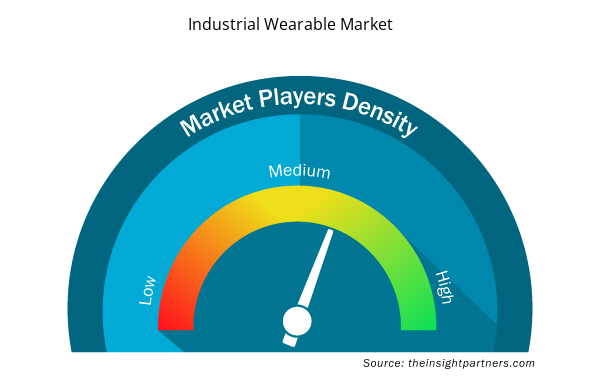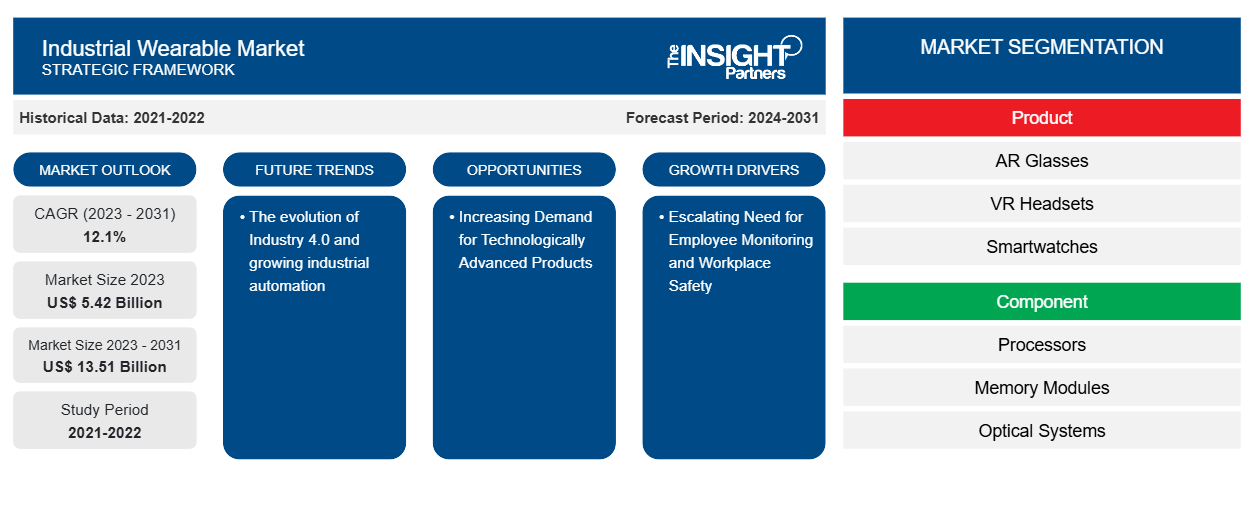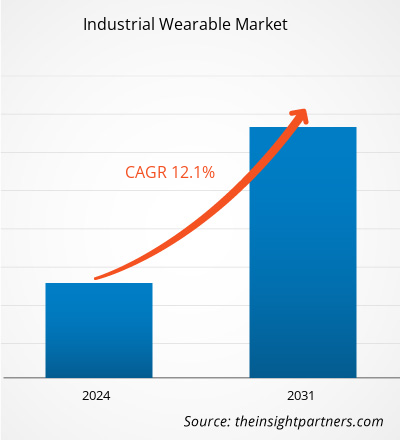産業用ウェアラブルの市場規模は、2023 年の 54.2 億米ドルから 2031 年には 135.1 億米ドルに達すると予測されています。市場は 2023 年から 2031 年にかけて 12.1% の CAGR を記録すると予想されています。インダストリー 4.0 の進化と産業オートメーションの拡大は、今後も産業用ウェアラブル市場の主要なトレンドであり続けると思われます。
産業用ウェアラブル市場分析
産業用ウェアラブル市場は、従業員の監視と職場の安全に対するニーズの高まりと、世界中の製造工場の増加により、急速に成長しています。市場は、協力的な作業環境に対する需要の高まりに牽引されて着実に拡大しています。さらに、技術的に高度な製品に対する需要の増加とスマート製造に対する需要の増加により、市場の成長に有利な機会が生まれています。
産業用ウェアラブル市場の概要
産業用ウェアラブルは、自動車、航空宇宙、製造、石油・ガス、エネルギー・電力などの業界で職場の安全性、生産性、効率性を向上させるために特別に設計された便利なデバイスです。これらのデバイスは、ユーザーの行動を追跡し、データを収集し、ユーザーの好みやニーズに基づいてパーソナライズされたエクスペリエンスを提供するための非常に高度な電子部品で構成されています。さらに、作業関連の危険を排除し、従業員が手元のタスクをより簡単に実行できるように設計されています。世界中で職場での事故が増加しているため、業界間で産業用ウェアラブルの需要が高まり、市場に大きな成長の機会が生まれています。
要件に合わせてレポートをカスタマイズする
このレポートの一部、国レベルの分析、Excelデータパックなど、あらゆるレポートを無料でカスタマイズできます。また、スタートアップや大学向けのお得なオファーや割引もご利用いただけます。
- このレポートの主要な市場動向を入手してください。この無料サンプルには、市場動向から見積もりや予測に至るまでのデータ分析が含まれます。
産業用ウェアラブル市場の推進要因と機会
従業員の監視と職場の安全に対するニーズの高まりが市場を牽引
多くの業界では、生産・製造現場全体で堅牢な機械、複雑なシステム、強力な設備を使用しています。これらの機械や設備は、鉱業、材料加工、鉄鋼製造、建設など、多くの業界で日常業務を効果的に遂行するために物理的に高度に使用されています。これらの業界は予期せぬエラーや事故による被害に対して特に脆弱であるため、職場の安全性を高めるための効果的な監視システムの需要が高まり、市場を牽引しています。さらに、計画外のエラーや事故の発生が増えると、労働者の安全を促進するための産業用ウェアラブルの需要が高まります。これらの予期しない職場の事故は、労働者を継続的に監視できる産業用ウェアラブルやその他のソリューションを使用することで防止できます。さらに、この業界でのこれらのアイテムの採用は、職場関連の安全要件と法律の急増によって支えられています。
技術的に高度な製品に対する需要の増加 - 産業用ウェアラブル市場におけるチャンス
技術の急速な進歩と、革新と小型化への重点の高まりにより、市場にチャンスが生まれています。さまざまな業界の組織が、スマートフォンやタブレットの代わりにウェアラブルに集中することで、IT のさらなる消費者化を試みています。産業用ウェアラブルは、重要な健康指標を監視し、緊急時に迅速に対応できるように業界をサポートするため、業界での採用が増えています。さらに、IoT、AI、クラウドベースの産業用ウェアラブルは、通知や情報を瞬時に直感的に提供し、警告灯やチャイムの必要性を排除します。
産業用ウェアラブル市場レポートのセグメンテーション分析
産業用ウェアラブル市場分析の導出に貢献した主要なセグメントは、製品、コンポーネント、およびエンドユーザー業界です。
- 製品別に見ると、産業用ウェアラブル市場は、ARグラス、VRヘッドセット、スマートウォッチ、スマートバンド、パッチ、その他に分類されます。ARグラスセグメントは、2023年に大きな市場シェアを占めました。
- コンポーネントに基づいて、産業用ウェアラブル市場は、プロセッサとメモリモジュール、光学システムとディスプレイ、電気機械コンポーネント、タッチパッドとセンサー、接続コンポーネント、カメラモジュール、その他に分類されます。光学システムとディスプレイセグメントは、2023年に大きな市場シェアを占めました。
- エンドユーザー業界の観点から見ると、産業用ウェアラブル市場は、自動車、航空宇宙、製造、石油・ガス、エネルギー・電力、その他に分類されます。自動車部門は2023年に大きな市場シェアを占めました。
産業用ウェアラブル市場シェアの地域別分析
産業用ウェアラブル市場レポートの地理的範囲は、主に北米、アジア太平洋、ヨーロッパ、中東およびアフリカ、南米/中南米の 5 つの地域に分かれています。
収益の面では、Vuzix Corporation、Blackline Safety Corp.、Kenzen, Inc.などの大手企業の存在により、北米市場が最大の産業用ウェアラブル市場シェアを占めています。これらの企業は、労働者の安全性を高めるために、技術的に高度なウェアラブルに取り組んでいます。これらの企業は、多様なエンドユーザー業界の需要を満たすために、さまざまなウェアラブル、特にARグラスとVRヘッドセットの作成に注力しています。北米の市場は予測期間中に成長すると予測されており、運用生産性を向上させるために業界によるコネクテッドテクノロジーとデジタルテクノロジーの採用が増加しています。さらに、自動車業界での自動車モデルのセットアップ、構成、キャリブレーション、品質検査の自動化を目的としたARグラスの需要の増加が、北米の市場を押し上げています。
産業用ウェアラブル市場地域別インサイト
予測期間を通じて産業用ウェアラブル市場に影響を与える地域的な傾向と要因は、Insight Partners のアナリストによって徹底的に説明されています。このセクションでは、北米、ヨーロッパ、アジア太平洋、中東、アフリカ、南米、中米にわたる産業用ウェアラブル市場のセグメントと地理についても説明します。

- 産業用ウェアラブル市場の地域別データを入手
産業用ウェアラブル市場レポートの範囲
| レポート属性 | 詳細 |
|---|---|
| 2023年の市場規模 | 54.2億米ドル |
| 2031年までの市場規模 | 135億1000万米ドル |
| 世界のCAGR(2023年~2031年) | 12.1% |
| 履歴データ | 2021-2022 |
| 予測期間 | 2024-2031 |
| 対象セグメント | 製品別
|
| 対象地域と国 | 北米
|
| 市場リーダーと主要企業プロフィール |
|
産業用ウェアラブル市場のプレーヤー密度:ビジネスダイナミクスへの影響を理解する
産業用ウェアラブル市場は、消費者の嗜好の変化、技術の進歩、製品の利点に対する認識の高まりなどの要因により、エンドユーザーの需要が高まり、急速に成長しています。需要が高まるにつれて、企業は提供品を拡大し、消費者のニーズを満たすために革新し、新たなトレンドを活用し、市場の成長をさらに促進しています。
市場プレーヤー密度とは、特定の市場または業界内で活動している企業または会社の分布を指します。これは、特定の市場スペースに、その規模または総市場価値と比較して、どれだけの競合相手 (市場プレーヤー) が存在するかを示します。
産業用ウェアラブル市場で事業を展開している主要企業は次のとおりです。
- ブラックラインセーフティ株式会社
- ケンゼン株式会社
- キネティック
- マクサフェ
- 株式会社モジュール
- リアクテック株式会社
免責事項:上記の企業は、特定の順序でランク付けされていません。

- 産業用ウェアラブル市場のトップキープレーヤーの概要を入手
産業用ウェアラブル市場のニュースと最近の動向
産業用ウェアラブル市場は、主要な企業出版物、協会データ、データベースなどの一次調査と二次調査後の定性的および定量的データを収集することで評価されます。以下は、産業用ウェアラブル市場の動向と戦略のリストです。
- 2024 年 4 月、Vuzix Corporation は、主にこの顧客の倉庫保管と物流のニーズをサポートするために、Fortune 100 のグローバル小売業者から Vuzix M400 スマートグラスの追加注文を受けました。Vuzix スマートグラスは現在、米国、カナダ、メキシコ、EMEA 全域を含む世界中の複数の場所で使用されており、この顧客は 2024 年の初めから、ますます多くの会社の拠点に拡大し続けています。(出典: Vuzix Corporation、プレスリリース、2024 年)
産業用ウェアラブル市場レポートの対象範囲と成果物
「産業用ウェアラブル市場の規模と予測(2021〜2031年)」レポートでは、以下の分野をカバーする市場の詳細な分析を提供しています。
- 対象範囲に含まれるすべての主要市場セグメントの世界、地域、国レベルでの市場規模と予測
- 市場の動向(推進要因、制約、主要な機会など)
- 今後の主な動向
- 詳細なPEST/ポーターの5つの力とSWOT分析
- 主要な市場動向、主要プレーヤー、規制、最近の市場動向を網羅した世界および地域の市場分析
- 市場集中、ヒートマップ分析、主要プレーヤー、最近の動向を網羅した業界の状況と競争分析
- 詳細な企業プロフィール
- 過去2年間の分析、基準年、CAGRによる予測(7年間)
- PEST分析とSWOT分析
- 市場規模価値/数量 - 世界、地域、国
- 業界と競争環境
- Excel データセット



Report Coverage
Revenue forecast, Company Analysis, Industry landscape, Growth factors, and Trends

Segment Covered
This text is related
to segments covered.

Regional Scope
North America, Europe, Asia Pacific, Middle East & Africa, South & Central America

Country Scope
This text is related
to country scope.
よくある質問
The incremental growth expected to be recorded for the global industrial wearable market during the forecast period is US$ 8.08 billion.
The global industrial wearable market is expected to reach US$ 13.51 billion by 2031.
The key players holding majority shares in the global industrial wearable market are Blackline Safety Corp., Kenzen, Inc., Kinetic, MaKusafe, and Modjoul, Inc.
The evolution of Industry 4.0 and growing industrial automation to play a significant role in the global industrial wearable market in the coming years.
The escalating need for employee monitoring and workplace safety and an increasing number of manufacturing plants worldwide are the major factors that propel the global industrial wearable market.
The global industrial wearable market was estimated to be US$ 5.42 billion in 2023 and is expected to grow at a CAGR of 12.1% during the forecast period 2023 - 2031.
Trends and growth analysis reports related to Electronics and Semiconductor : READ MORE..
The Insight Partners performs research in 4 major stages: Data Collection & Secondary Research, Primary Research, Data Analysis and Data Triangulation & Final Review.
- Data Collection and Secondary Research:
As a market research and consulting firm operating from a decade, we have published and advised several client across the globe. First step for any study will start with an assessment of currently available data and insights from existing reports. Further, historical and current market information is collected from Investor Presentations, Annual Reports, SEC Filings, etc., and other information related to company’s performance and market positioning are gathered from Paid Databases (Factiva, Hoovers, and Reuters) and various other publications available in public domain.
Several associations trade associates, technical forums, institutes, societies and organization are accessed to gain technical as well as market related insights through their publications such as research papers, blogs and press releases related to the studies are referred to get cues about the market. Further, white papers, journals, magazines, and other news articles published in last 3 years are scrutinized and analyzed to understand the current market trends.
- Primary Research:
The primarily interview analysis comprise of data obtained from industry participants interview and answers to survey questions gathered by in-house primary team.
For primary research, interviews are conducted with industry experts/CEOs/Marketing Managers/VPs/Subject Matter Experts from both demand and supply side to get a 360-degree view of the market. The primary team conducts several interviews based on the complexity of the markets to understand the various market trends and dynamics which makes research more credible and precise.
A typical research interview fulfils the following functions:
- Provides first-hand information on the market size, market trends, growth trends, competitive landscape, and outlook
- Validates and strengthens in-house secondary research findings
- Develops the analysis team’s expertise and market understanding
Primary research involves email interactions and telephone interviews for each market, category, segment, and sub-segment across geographies. The participants who typically take part in such a process include, but are not limited to:
- Industry participants: VPs, business development managers, market intelligence managers and national sales managers
- Outside experts: Valuation experts, research analysts and key opinion leaders specializing in the electronics and semiconductor industry.
Below is the breakup of our primary respondents by company, designation, and region:

Once we receive the confirmation from primary research sources or primary respondents, we finalize the base year market estimation and forecast the data as per the macroeconomic and microeconomic factors assessed during data collection.
- Data Analysis:
Once data is validated through both secondary as well as primary respondents, we finalize the market estimations by hypothesis formulation and factor analysis at regional and country level.
- Macro-Economic Factor Analysis:
We analyse macroeconomic indicators such the gross domestic product (GDP), increase in the demand for goods and services across industries, technological advancement, regional economic growth, governmental policies, the influence of COVID-19, PEST analysis, and other aspects. This analysis aids in setting benchmarks for various nations/regions and approximating market splits. Additionally, the general trend of the aforementioned components aid in determining the market's development possibilities.
- Country Level Data:
Various factors that are especially aligned to the country are taken into account to determine the market size for a certain area and country, including the presence of vendors, such as headquarters and offices, the country's GDP, demand patterns, and industry growth. To comprehend the market dynamics for the nation, a number of growth variables, inhibitors, application areas, and current market trends are researched. The aforementioned elements aid in determining the country's overall market's growth potential.
- Company Profile:
The “Table of Contents” is formulated by listing and analyzing more than 25 - 30 companies operating in the market ecosystem across geographies. However, we profile only 10 companies as a standard practice in our syndicate reports. These 10 companies comprise leading, emerging, and regional players. Nonetheless, our analysis is not restricted to the 10 listed companies, we also analyze other companies present in the market to develop a holistic view and understand the prevailing trends. The “Company Profiles” section in the report covers key facts, business description, products & services, financial information, SWOT analysis, and key developments. The financial information presented is extracted from the annual reports and official documents of the publicly listed companies. Upon collecting the information for the sections of respective companies, we verify them via various primary sources and then compile the data in respective company profiles. The company level information helps us in deriving the base number as well as in forecasting the market size.
- Developing Base Number:
Aggregation of sales statistics (2020-2022) and macro-economic factor, and other secondary and primary research insights are utilized to arrive at base number and related market shares for 2022. The data gaps are identified in this step and relevant market data is analyzed, collected from paid primary interviews or databases. On finalizing the base year market size, forecasts are developed on the basis of macro-economic, industry and market growth factors and company level analysis.
- Data Triangulation and Final Review:
The market findings and base year market size calculations are validated from supply as well as demand side. Demand side validations are based on macro-economic factor analysis and benchmarks for respective regions and countries. In case of supply side validations, revenues of major companies are estimated (in case not available) based on industry benchmark, approximate number of employees, product portfolio, and primary interviews revenues are gathered. Further revenue from target product/service segment is assessed to avoid overshooting of market statistics. In case of heavy deviations between supply and demand side values, all thes steps are repeated to achieve synchronization.
We follow an iterative model, wherein we share our research findings with Subject Matter Experts (SME’s) and Key Opinion Leaders (KOLs) until consensus view of the market is not formulated – this model negates any drastic deviation in the opinions of experts. Only validated and universally acceptable research findings are quoted in our reports.
We have important check points that we use to validate our research findings – which we call – data triangulation, where we validate the information, we generate from secondary sources with primary interviews and then we re-validate with our internal data bases and Subject matter experts. This comprehensive model enables us to deliver high quality, reliable data in shortest possible time.


 このレポートの無料サンプルを入手する
このレポートの無料サンプルを入手する